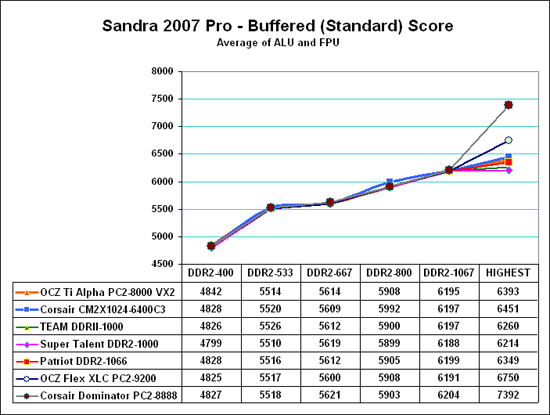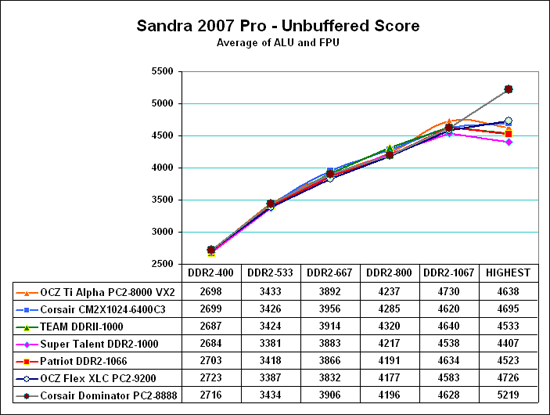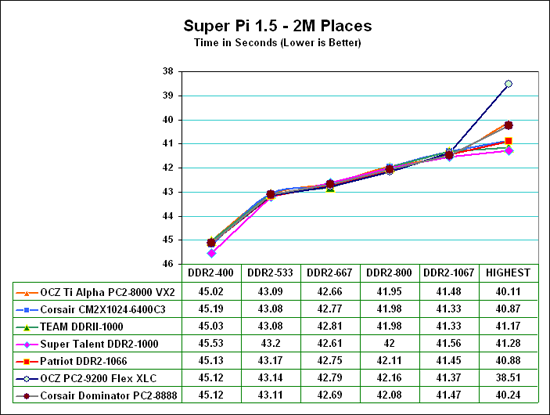Corsair Dominator DDR2-1111: Dual-Path Cooling Pushes Performance
by Wesley Fink on January 1, 2007 5:15 AM EST- Posted in
- Memory
Memory Bandwidth Scaling
Memory bandwidth normally improves with increases in memory speed and reductions in memory timings. This is best illustrated using Performance Scaling charts.
Since the results for high-end memory were so close at all tested speeds, the scale range was reduced to better show the small differences in these memory benchmark results. Please keep this in mind when viewing the charts, since a normal zero scale would make performance differences appear much smaller than these expanded scale charts. Test values for each memory at each speed are included below each chart for reference.
To evaluate memory bandwidth SiSoft Sandra 2007 Professional was used to evaluate standard Buffered performance and Unbuffered memory bandwidth.

The most widely reported Sandra score is the Standard or Buffered memory score. This benchmark takes into account the buffering schemes like MMX, SSE, SSE2, SSE3, and other buffering tools that are used to improve memory performance. The Buffered benchmark does not correlate well with real performance differences in games, so our memory bandwidth tests have always included an Unbuffered Sandra memory score. The Unbuffered result turns off the buffering schemes, and we have found the differences in unbuffered results correlate well with real-world performance differences.

In both Buffered and Unbuffered tests Corsair Dominator performance curves mirror the best memory tested to DDR2-1066. While the differences are extremely small, Dominator more often than not is the fastest memory we have tested at any given speed. This is what would be expected since Dominator is based on the same core memory chips as the other tested memories. Memory bandwidth increases dramatically at the top in buffered bandwidth (standard test) on the 680i. This is mostly a result of the much higher overclock in memory that could be achieved with the Corsair compared to other Micron D-based memory. Unbuffered results also increase at the top speed, but not as dramatically as buffered results.
We also compared results with Version 1.5 of Super Pi - comparing the time to calculate two million places of Pi at the different memory speeds. This benchmark measures pure number crunching.

Super Pi results continue to improve to the highest speed that could be reached with stability with Corsair Dominator and other tested memories. What also stands out is how close the results with all the memories really are from DDR2-400 to DDR2-1066. This is mainly a reflection of the fact that compared memories are based on the same base Micron memory chips. At the highest speed Corsair Dominator and OCZ Flex XLC pull away from the pack with the record overclocks. The real difference between top overclock Super Pi results and stock DDR2-1067 results is very close. This shows the impact of CPU speed on calculation performance is much greater than the impact of memory speed increases.
Memory bandwidth normally improves with increases in memory speed and reductions in memory timings. This is best illustrated using Performance Scaling charts.
Since the results for high-end memory were so close at all tested speeds, the scale range was reduced to better show the small differences in these memory benchmark results. Please keep this in mind when viewing the charts, since a normal zero scale would make performance differences appear much smaller than these expanded scale charts. Test values for each memory at each speed are included below each chart for reference.
To evaluate memory bandwidth SiSoft Sandra 2007 Professional was used to evaluate standard Buffered performance and Unbuffered memory bandwidth.

The most widely reported Sandra score is the Standard or Buffered memory score. This benchmark takes into account the buffering schemes like MMX, SSE, SSE2, SSE3, and other buffering tools that are used to improve memory performance. The Buffered benchmark does not correlate well with real performance differences in games, so our memory bandwidth tests have always included an Unbuffered Sandra memory score. The Unbuffered result turns off the buffering schemes, and we have found the differences in unbuffered results correlate well with real-world performance differences.

In both Buffered and Unbuffered tests Corsair Dominator performance curves mirror the best memory tested to DDR2-1066. While the differences are extremely small, Dominator more often than not is the fastest memory we have tested at any given speed. This is what would be expected since Dominator is based on the same core memory chips as the other tested memories. Memory bandwidth increases dramatically at the top in buffered bandwidth (standard test) on the 680i. This is mostly a result of the much higher overclock in memory that could be achieved with the Corsair compared to other Micron D-based memory. Unbuffered results also increase at the top speed, but not as dramatically as buffered results.
We also compared results with Version 1.5 of Super Pi - comparing the time to calculate two million places of Pi at the different memory speeds. This benchmark measures pure number crunching.

Super Pi results continue to improve to the highest speed that could be reached with stability with Corsair Dominator and other tested memories. What also stands out is how close the results with all the memories really are from DDR2-400 to DDR2-1066. This is mainly a reflection of the fact that compared memories are based on the same base Micron memory chips. At the highest speed Corsair Dominator and OCZ Flex XLC pull away from the pack with the record overclocks. The real difference between top overclock Super Pi results and stock DDR2-1067 results is very close. This shows the impact of CPU speed on calculation performance is much greater than the impact of memory speed increases.










14 Comments
View All Comments
classy - Monday, January 1, 2007 - link
It won't be on memory that gives me an extra 2-5 frames. While it performs well, it just doesn't make enough of a performance impact to warrant the price. Maybe for a dream system but for the other 99.75% of the pc world this memory is clearly a waste of money.code255 - Sunday, January 7, 2007 - link
Totally agree. Buying super high quality memory is an utter waste of money. Double the cost of normal RAM for like 1% higher framerates? Thanks, but no f***ing thanks!I usually buy value RAM from decent manufacturers (which is more expensive than from no-name brands) just for the sake of stability. RAM just doesn't have a significant enough impact on gaming performance to justify the insane prices of the top-of-the-line stuff.
tayhimself - Tuesday, January 2, 2007 - link
This is such another example of reviews driven by ridiculous marketing than by product reviews that may be worthwhile or beneficial to 99% of readers. I don't doubt there are people spending $600 on 2 GB of DDR2 to get that extra 1.5% performance boost, I just doubt there are very many of them.A review of value RAM sticks on 965, 975x, or 590 chipsets would be far more useful and informative because of ridiculous compatibility issues with mobos. But alas these reviews rarely happen...
bigboxes - Monday, January 1, 2007 - link
It's nice to see Corsair finally getting back into the game. Here's to prices dropping, though it may be a while. :)